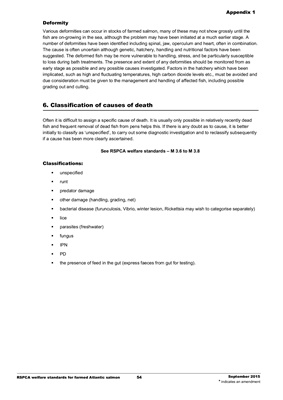
Appendix 1
RSPCA welfare standards for farmed Atlantic salmon 54 September 2015
* indicates an amendment
Deformity
Various deformities can occur in stocks of farmed salmon, many of these may not show grossly until the
fish are on-growing in the sea, although the problem may have been initiated at a much earlier stage. A
number of deformities have been identified including spinal, jaw, operculum and heart, often in combination.
The cause is often uncertain although genetic, hatchery, handling and nutritional factors have been
suggested. The deformed fish may be more vulnerable to handling, stress, and be particularly susceptible
to loss during bath treatments. The presence and extent of any deformities should be monitored from as
early stage as possible and any possible causes investigated. Factors in the hatchery which have been
implicated, such as high and fluctuating temperatures, high carbon dioxide levels etc., must be avoided and
due consideration must be given to the management and handling of affected fish, including possible
grading out and culling.
6. Classification of causes of death
Often it is difficult to assign a specific cause of death. It is usually only possible in relatively recently dead
fish and frequent removal of dead fish from pens helps this. If there is any doubt as to cause, it is better
initially to classify as 'unspecified', to carry out some diagnostic investigation and to reclassify subsequently
if a cause has been more clearly ascertained.
See RSPCA welfare standards - M 3.6 to M 3.8
Classifications:
unspecified
runt
predator damage
other damage (handling, grading, net)
bacterial disease (furunculosis, Vibrio, winter lesion, Rickettsia may wish to categorise separately)
lice
parasites (freshwater)
fungus
IPN
PD
the presence of feed in the gut (express faeces from gut for testing).